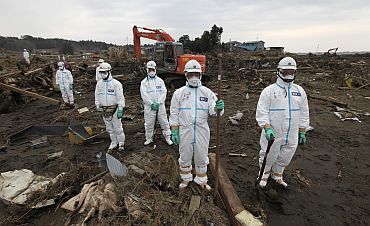 | « Back to article | Print this article |
'Nine months' to bring Japan's N-crisis under control
Tokyo Electric Power Company, the embattled operator of the plant, said it hopes to bring the damaged reactors at the six-unit Fukushima nuclear power station to a stable condition known as a "cold shutdown" in about six to nine months. It said the stable cooling to the reactors and spent fuel pools is expected to be restored in about three months.
Announcing TEPCO's phased roadmap "for the moment" for bringing the complex in Fukushima prefecture under control, the utility's Chairman Tsunehisa Katsumata offered apology for the ongoing nuclear crisis triggered by the March 11 quake and tsunami that have left nearly 30,000 people dead or unaccounted for in Japan's northeast.
TEPCO said it needs three months to achieve "steady reduction" in radiation and an additional three to six months to control radioactive emissions and curb radiation substantially. It said it is addressing the immediate challenges of preventing hydrogen explosions at the No 1 to No 3 reactors of the plant and emission of water contaminated with high-level radiation from the No. 2 reactor.Click on NEXT to read further...
US to help Japan in reconstruction efforts
Clinton had tea with Emperor Akhito at the Imperial Palace after the monarch extended her a rare invitation, which is usually done in the the case of the head of a state. She also held talks with Japanese Prime Minister Naoto Kan and her Japanese counterpart Takeaki Matsumoto.
The US is confident that Japan would recover and act as a very strong economic and global player for years to come, Clinton told Kan, who thanked her for the US help.
Clinton, who addressed a joint press conference with Matsumoto, pledged unwavering support for Japan in the process of rebuilding of the nation, while her Japanese counterpart vowed that Tokyo will "fully disclose" information on its battle to contain the emergency at the Fukushima nuclear plant.
Clinton, the highest-ranking US official to visit Japan after last month's natural disaster, expressed confidence that this country would "emerge even stronger" than before.
Japan and the US also agreed to set up a new public-private initiative to help Japanese reconstruction efforts, with business leaders from the two countries endorsing the idea at the joint news conference.
No expansion of evacuation zone in Fukushima
The top government spokesman also told Sato that the government would do its utmost to prevent farmers from Fukushima suffering financially due to misperceptions among consumers about the effects of the nuclear accident at the Fukushima Daiichi power plant. However, Edano declined to specify when residents of the 20-km evacuation radius around the nuclear plant would be able to return temporarily to collect belongings and inspect their homes, while Sato said he expected the government to act on the disaster-hit people's behalf.
Regarding the possible expansion of the evacuation zone, Edano indicated that it was not being considered by the government, and would not be unless there was a further deterioration of conditions surrounding the nuclear plant.
US-made robots to be used for measuring radiation levels
TEPCO hopes to begin transfer of the water some time this week to a nuclear waste facility that can hold 30,000 tonnes of such water. It is now conducting final checks so that leaks of radioactive material will not occur from the facility. The level of radioactive substances is also increasing at facilities where underground water from the Nos. 1 and 2 reactors is collected. The concentration of cesium-134 on Wednesday was 38 times the reading a week earlier.
TEPCO is also set to start using US-made robots for measuring radiation levels and taking pictures inside the reactor's buildings. High levels of radiation have prevented workers from entering the area to contain the situation.
According to the National Police Agency, 13,705 people have been confirmed dead and 14,175 listed as unaccounted for after the March 11 earthquake and tsunami. Most of the deaths occurred in Miyagi, Iwate and Fukushima, the three hardest-hit prefectures. Miyagi tops the list with 8,360 deaths, followed by Iwate at 3,952 and Fukushima at 1,330.



